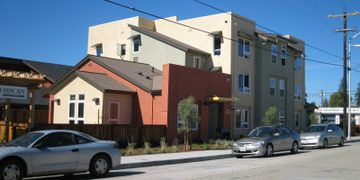Projects

Our projects have included multi-story commercial buildings, small and large bridge crossings, industrial buildings, green energy facilities, single-family homes, coastal bluff stabilization, schools, and more. A few of our projects are highlighted below.
1035 Cayuga Street

New fifteen-unit three-story apartment complex and commercial building
In 2000, the former Grace United Methodist Church had a severe fire that required demolition of the church. The building was demolished and the basement was filled with undocumented fill material. The property was then sold and subdivided, and a new fifteen-unit apartment building was constructed at the site to house homeless persons with mental health disabilities.The soils below the proposed apartment building were loose in the top 3 to 4 feet; groundwater was encountered 5 feet below grade, and there was 3 to 8 feet of imported fill material where the old church basement was backfilled. To mitigate differential settlements, the loose native soils and the imported fill materials below the new apartment building were removed and replaced as compacted engineered fill. A conventional foundation was then used to support the new structure.The parking lot for the new building was constructed using pervious concrete pavement that allows rainwater to pass through the concrete into the underlying soils. The pervious pavement filters contaminants out of the water, recharges the groundwater table below the site, and provides an environmentally friendly solution for storm runoff control.
420 McCormick Avenue
5-lot minor land division
The existing site at 420 McCormick has a long history, and was once home to a water reservoir with a soil berm retention system. When Dees & Associates was awarded the contract, half of the soil berm had been removed, along with the reservoir, and a single family residence and detached garage occupied the lot.The project consisted of removing the existing single-family residence, detached garage and remaining soil berm to make way for five new single-family residences. The project was one of the first green building subdivision projects in the county, and is rated Silver by LEED (Leadership in Environmental and Energy Design).The home’s construction included recycled materials, solar panels and sustainable products. Dees & Associates provided drainage and on-site storm water recharge design recommendations as part of the green building design concept.
303 Potrero Street
Old Sash Mill
The Old Sash Mill development started in the mid-1970s with renovation of the existing buildings left from the original wood mill that had occupied portions of the site since 1906. Since then several additional buildings have been constructed at the site to complement the historic character of the property. The buildings are occupied by a diverse group of tenants ranging from professional offices to light manufacturing.Our firm provided geotechnical services for three of the most recent buildings constructed at the site and the associated road and parking areas. The three new buildings are two-story, with slab-on-grade foundations.Geotechnical challenges for the project included shallow groundwater and soft clayey soils at the ground surface. The shallow groundwater table and soft clays did not provide adequate bearing capacity for the proposed structures, so the top few feet of soil was removed from the foundation zone and replaced with compacted engineered fill. When the soft soil was removed, groundwater levels were higher than they were during our field investigation, and water began seeping into the excavation, making fill placement very difficult.To keep construction schedules on time, our firm designed a mechanically stabilized composite raft to support the proposed foundation. The composite raft consisted of multiple layers of stiff geogrid reinforcement and engineered fill that could be placed directly on top of the soft saturated soils at the base of the excavation. Rather than remove the soft clayey subgrade soils, the parking and driveway areas were lime-treated and compacted.